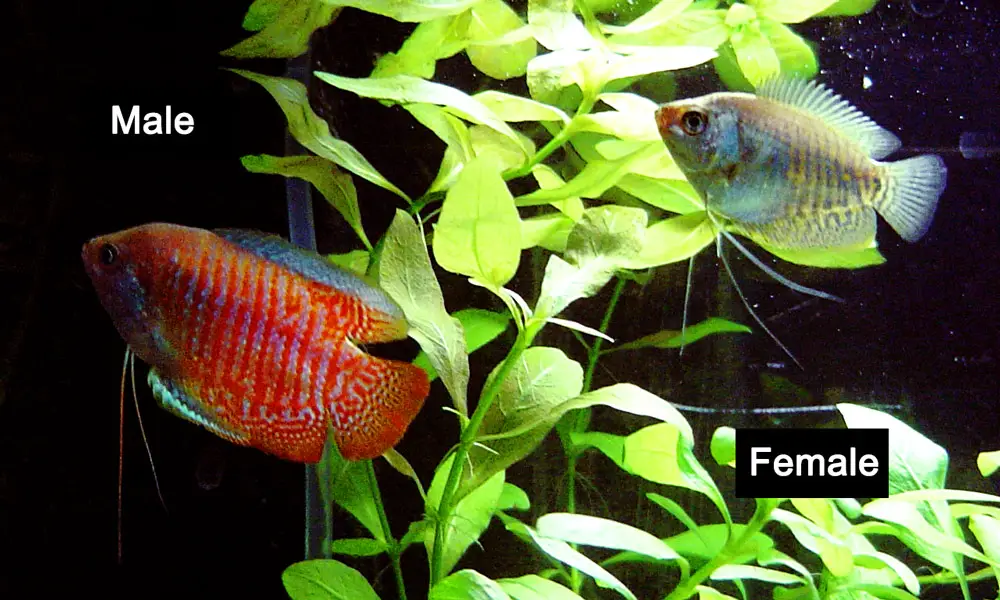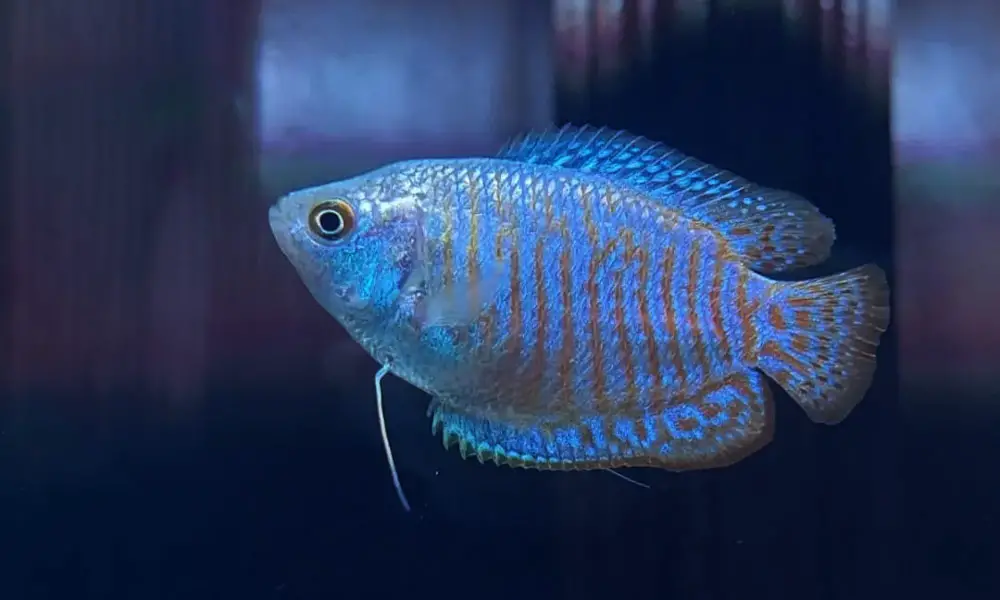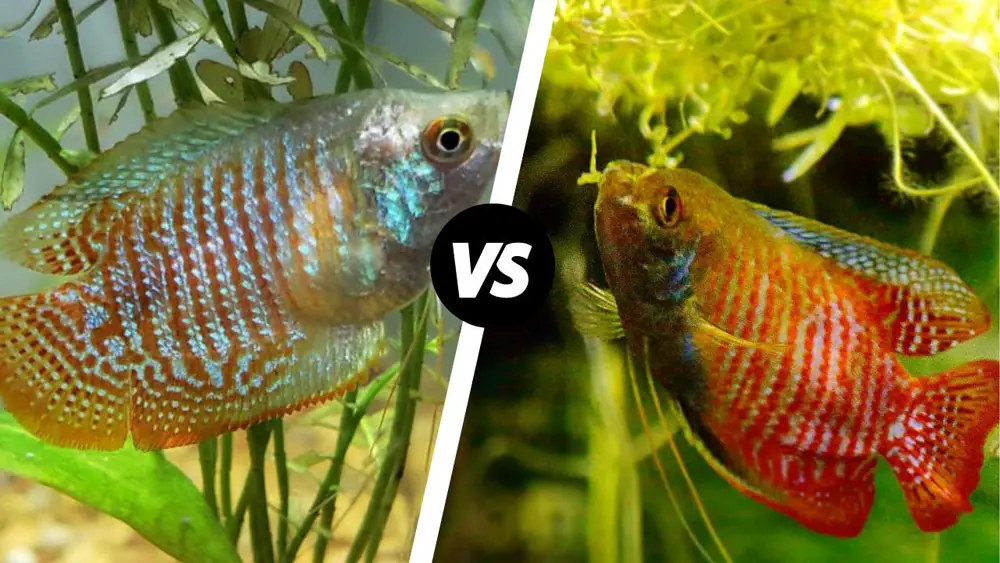If you’re like me, your home aquarium is a source of constant fascination and delight. Watching the fish swim around in their little world never fails to make me feel calm and peaceful. And if there’s one fish that really captures my heart, it’s the dwarf gourami.
These lively little creatures are always a joy to watch, and they add a splash of color to your aquarium. Additionally, Dwarf Gourami won’t require a lot of work on your part to keep them healthy and happy.
However, telling the male from female dwarf gourami can’t be done the same way as determining the gender of most livebearers.
If you’re thinking about breeding dwarf gourami, it’s important to know how to sex them so you can choose a pair of fish that will be compatible.
In this article, we’ll learn some of the key differences between male and female dwarf gouramis and how they breed.
Without further ado, let’s dive in!
Female Dwarf Gourami Facts
Before we get into how to differentiate between male and female dwarf gourami, let’s take a quick look at some general facts about these lovely fish.
Species Overview
The dwarf gourami, also known as Trichogaster Ialius, belongs to a small genus Trichogaster, which only has four recognized species. Unlike these medium sized to large species from the genus Osphronemus, Belontia and Macropodus, the Trichogaster species are a peaceful and shy fish.
Dwarf gouramis are labyrinth fish. They have a labyrinth organ behind their gills, which acts like a primitive lung, allowing them to breathe air directly from the surface.
Origin and Distribution
Dwarf gouramis hail from the thickly vegetated waters in India, West Bengal, Assam, and Bangladesh in South Asia. They are sold as common food fish in many markets in northern India.
Lifespan
Both male and female dwarf gourami have an average lifespan of 4 years when well-cared for in captivity. Their lifespan may be much shorter due to stress, poor diet, and poor water conditions.
Color Variations
Since these fish are beautiful in nature, breeders have developed many color morphs over the years. The most common colors you’ll see in pet stores are neon blue, red flame, and powder blue.
Unfortunately, most selective breeding or dyed dwarf gouramis are typically only males. Female dwarf gouramis with these man-made morphs come with a hefty price tag.
Female Neon Blue Dwarf Gourami
The Neon Blue Dwarf Gourami gets its name from its beautiful, iridescent blue coloration than the standard variety. This is the most notable color morph in the trade.
Female Powder Blue Dwarf Gourami
Often referred to as Coral Blue Dwarf Gourami and Blue Dwarf Gourami, the powder blue morph is almost entirely bright blue with only a little red striping, which is one of the most solid varieties.
Female Red Flame Dwarf Gourami
The flame-red variety can be confused with the red honey gouramis. It takes on bright orange and red colors that resemble a flickering flame extending to its fins.
Male Vs. Female Dwarf Gourami

Now that we know a little more about these beautiful fish, let’s take a look at how to tell the difference between male and female dwarf gourami.
Dorsal (top) Fin
Why not start off with the most distinctive difference between adult males and females? The adult female dwarf gouramis have a curved and rounded dorsal fin, while the males are longer and pointier.
It’s hard to differentiate this characteristic when they are young since both females and males have short and rounded fins. The males’ dorsal fins will grow faster and become more pointed as they reach sexual maturity.
Size
Its common name “dwarf” describes this fish well. It stays small in any color variation. But female dwarf gouramis are a bit smaller than males, with the average length being 2.5 inches (6.4 cm), whereas males can grow up to 3 inches (7.6 cm) in length.
Body Shape
When it comes to the body shape of male and female dwarf gouramis, the males have a smaller belly, making them slimmer and more elongated in overall girth. While females develop a rounded belly, especially when they are ready to lay eggs.
Coloration
Because the dwarf gourami is considered a sexual dimorphism, not only do the males and females have differences in size, body shape, and dorsal (top) fin but their colors also tend to differ.
In the wild, female dwarf gouramis usually have a duller greenish silvery coloration overall. Males, on the other hand, are more boldly colored with alternating red and blue stripes that are much more defined. Additionally, they may also be seen to have bars of blue and black extending onto the fins and an iridescent blue throat.
Dwarf Gourami Breeding

Dwarf Gouramis are readily bred in aquariums. The breeding is not too difficult like many other species of Gouramis, but owners have always found the behavior of male Dwarf Gouramis to be somewhat
unpredictable, making the whole process a bit more challenging.
This species is a typical bubble nest builder. In a breeding aquarium, you can see a male busy constructing its bubble nest, usually near the surface of the water. When the female is ready to spawn, she will be introduced into the male’s territory.
When the female releases her eggs into the water, the male will quickly scoop them up into his mouth and spit them into the bubble nest. Once these eggs are secured in the bubble nest, the pair will repeat their spawning several times until all eggs (from 300 to 800 ) have been released.
If there are other female dwarf gouramis in the breeding tank, the male may spawn with all of them.
The male will then take care of the eggs solely. They often become territorial and aggressive when protecting their eggs and fry. So, in order to avoid any potential problems, it’s best to remove the female after spawning has occurred.
The incubation period for the eggs is usually between 12 to 24 hours, and after hatching, the fry will remain in the bubble nest for another 3 to 5 days until they are able to swim on their own.
Remove the male from the breeding tank once the fry are free-swimming to prevent him from eating them.
You will have to feed them live foods such as brine shrimp or finely ground flakes during this time.
Breeding Tips
To help increase your chances of success, here are a few tips:
- Use a separate breeding tank that is at least 10 gallons in size.
- In the wild, they live in a trio, so it’s best to have a male-to-female ratio of at least 1:2.
- Provide plenty of live plants for the female to hide, such as Hornwort or Milfoil. Floating plants are appreciated for comfort. Sometimes, the male will use bits of plant material into the bubble nest.
- This species is a bubble nest builder. Thus, it is important to make sure your filtration is not too strong. An air-powered sponge filter or peat filtration will work.
- Try to adjust the water temperature to 82 degrees Fahrenheit to trigger spawning.
- It is critical to maintain a warm layer of water at the surface for the bubbles to float in and for the fry to develop their labyrinth organ, especially during the first few weeks.
- Keep an eye out for Dwarf Gourami Disease (aka Dwarf Gourami Iridovirus), a condition that is often fatal and has no known cure.
FAQs:
Are Female Dwarf Gouramis Aggressive?
Female Dwarf Gouramis are generally peaceful fish and can be kept with other peaceful community fish.
Do Female Dwarf Gouramis Build Bubbles Nests?
Yes, female Dwarf Gouramis may assist the male in building the bubble nest, but only males will take sole responsibility for the eggs and fry.
Can Female Betta Live with Dwarf Gouramis?
I would suggest not doing it unless your gouramis have different colors than the female betta in a large tank. In addition, the gouramis might nip at her tail.
What Do Female Dwarf Gouramis Eat?
In the wild, female Dwarf Gouramis eat mainly small bugs and larvae on the surface of waters. In captivity, they will accept a variety of living, fresh, and flake foods.
Where to Buy Female Dwarf Gourami?
The female Dwarf Gouram is widely available for purchase online and in pet stores. But females are generally less expensive than males.
How Many Female Dwarf Gouramis Can I Put in a 10 Gallon Tank?
Keep them in trios, with one male and two females in a 10-gallon tank. If you have four or more fish, I recommend adding an additional 5 gallons for each fish.
Why is My Female Dwarf Gourami Chasing/attacking the Male?
The female Dwarf Gourami might be chasing/attacking the male because she is either pregnant or wants to lay eggs.
Can You Keep Male and Female Dwarf Gourami Together?
Males and female Dwarf Gouramis can be kept together, but it is best to have a ratio of at least 1:2 (one male to two females). This will help avoid any aggression from the male.
Conclusion
Female Dwarf Gouramis can be distinguishable from males by their curved and rounded dorsal fin and duller silvery coloration.
Dwarf Gouramis are peaceful fish that makes a great addition to any community tank. They are hardy and easy to care for.
I hope this guide was helpful in giving you a better understanding of female Dwarf Gouramis. If you have any further questions, please feel free to ask in the comments below!
